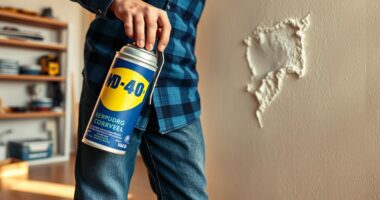If you want to upcycle old furniture into fresh, stylish pieces, start by repurposing dressers into sideboards with open shelving or adding paint and distressing for a vintage vibe. You can turn vintage chairs into modern statement pieces with new fabric or bold colors. Ladders become charming shelves, while mirrors can be transformed into textured wall decor. Nightstands can become eye-catching side tables. Keep exploring for more creative, eco-friendly ideas to refresh your space.
Key Takeaways
- Repurpose dressers into stylish storage units or sideboards with painting, distressing, and added shelving for a fresh look.
- Transform vintage chairs by reupholstering and painting to create modern, eclectic accent pieces.
- Convert ladders into functional shelving or plant stands, customizing with paint or stain for unique decor.
- Turn old mirrors into wall art with layered paint, texture, and mixed media for vintage or contemporary effects.
- Refurbish nightstands or small furniture pieces with sanding, painting, and hardware updates to suit new spaces.
Transforming Dressers Into Stylish Sideboards
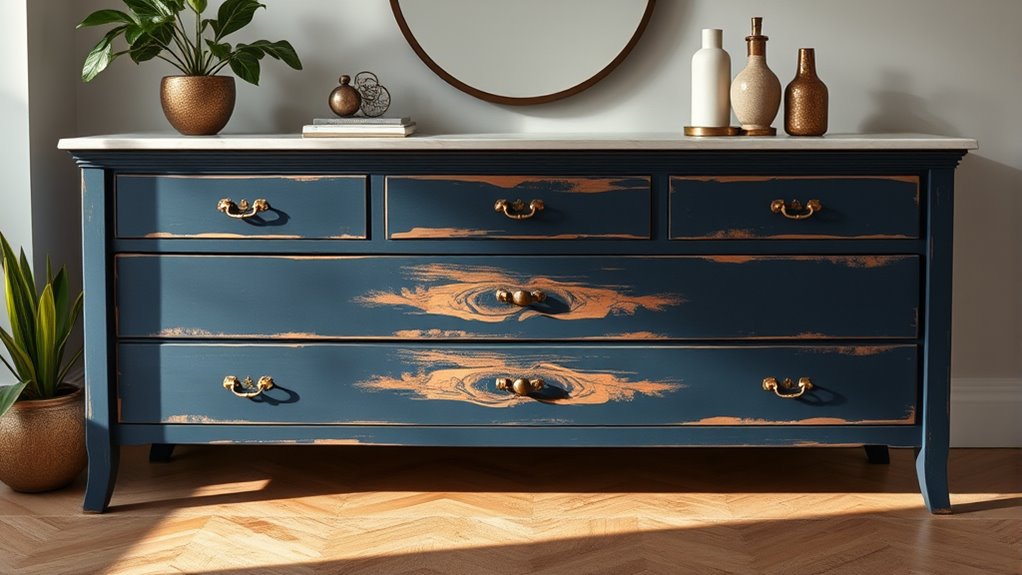
Transforming an old dresser into a stylish sideboard is a rewarding DIY project that combines creativity with practicality. Start by thoroughly cleaning the piece with a TSP cleaner to remove grime.
Transform an old dresser into a chic, functional sideboard with simple cleaning and painting steps.
Sand the surfaces, beginning with 80-120 grit for stained areas, then switch to 220 grit for a smooth finish—use only 220 grit on parts you’ll paint to ensure good adhesion. Remove hardware like handles and knobs for even coverage.
Once cleaned and sanded, let it dry completely. Apply high-quality chalk or latex paint with angled brushes and rollers, layering thin coats to prevent drips. Consider neutral tones for a modern look. Incorporating water-based polycrylic can help protect the paint finish and increase durability.
Sealing your project with the right protective coating not only preserves the look but also enhances longevity. Incorporating AI-driven analytics can help you assess the success of your project by tracking how well your furniture is received or sold if you decide to resell. Additionally, selecting appropriate primer can improve paint adhesion and reduce the chances of chipping over time. With these steps, your dresser transforms into a sleek, functional sideboard that enhances any space. Check local store hours to plan your shopping trip for supplies.
Giving Vintage Chairs a Modern Makeover

Giving vintage chairs a modern makeover is a great way to blend timeless charm with contemporary style. Start by reupholstering with fresh, modern fabrics—think bold patterns, luxe textures, or eco-friendly patchwork—to instantly refresh the look. Choose vibrant paint colors like raw silk or cathedral taupe, and experiment with techniques such as color-blocking or dipping to add visual interest. You can also enhance the frame by painting it or updating hardware like legs and armrests for a sleek, current appearance. Structural upgrades, like replacing cushions or refurbishing the frame, boost comfort and stability. Incorporating upcycling ideas can inspire creative transformations and sustainable practices. Consider blending vintage elements with modern materials to maintain character while embracing current trends. This approach creates a unique piece that’s both stylish and functional, perfect for any contemporary space, especially when you explore candle-making tips to add cozy, personalized accents. Additionally, exploring Hackathons can foster innovative ideas and community engagement for creative projects like furniture upcycling. Engaging in sustainable practices ensures your renovations are eco-friendly and contribute positively to environmental efforts.
Repurposing Ladders as Functional Shelving Units
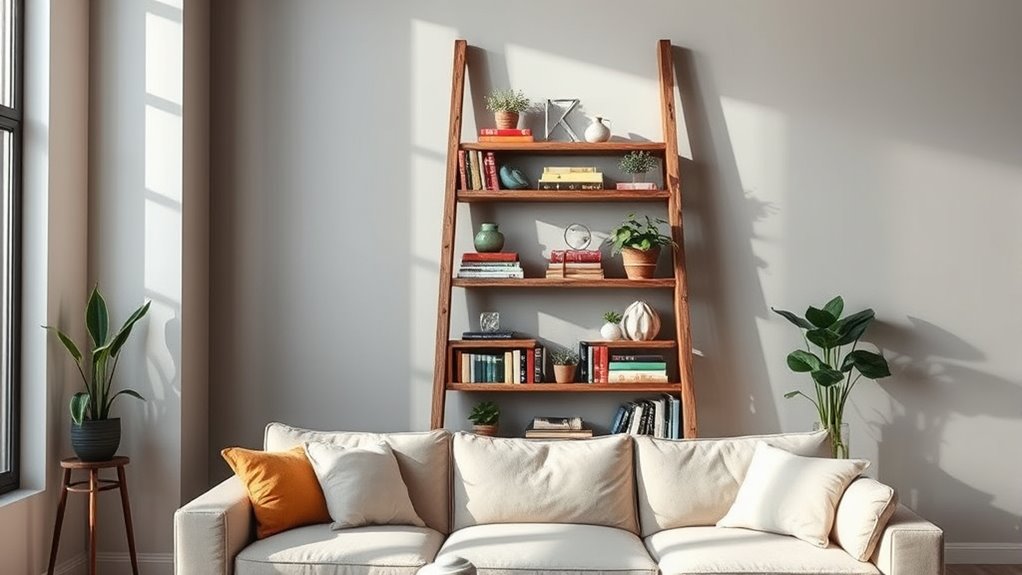
Repurposing old ladders into functional shelving units is a creative way to add both storage and style to your space. Choose wooden ladders for their vintage charm, especially those with one-sided rungs and small braces for sturdy support. You can find suitable ladders at secondhand construction material retailers or thrift stores.
Before starting, verify the ladder is structurally sound to safely hold shelves. Use wood boards around 11 to 12 inches wide, cutting standard 8-foot lengths into manageable 4-foot shelves. Secure shelves with screws, brackets, or crates, and consider wall anchoring for stability. Proper setup ensures the safety and durability of your ladder shelves. Proper calibration of your setup impacts the overall visual appeal and can be enhanced by proper calibration of your setup. Additionally, understanding fuel injection cleaning can help maintain your vehicle’s performance if you plan to transport or deliver your finished furniture. Incorporating sustainable practices during your project can also reduce environmental impact and promote eco-friendly craftsmanship. Regular inspections and vacuum cleaner performance metrics can help keep your workspace clean and safe during the project. Finish with sanding, staining, or paint to match your decor. Remember to check weight limits and add non-slip pads to prevent accidents, ensuring your ladder shelves are both beautiful and safe.
Upcycling Mirrors Into Artistic Wall Decor
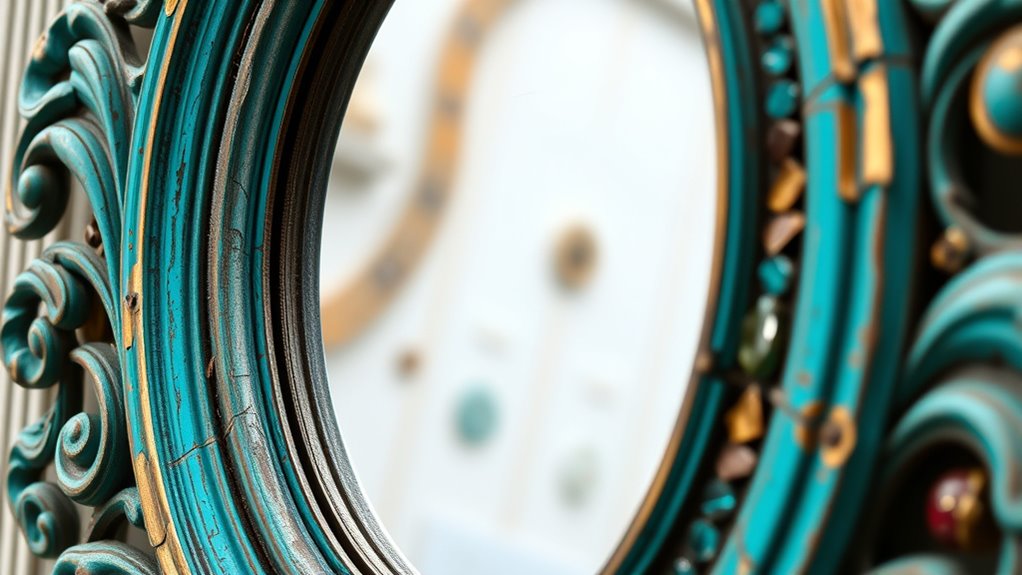
Upcycling mirrors into artistic wall decor offers a creative way to personalize your space and showcase your style. You can apply paint techniques like distressing, layering, or stenciling to transform plain frames into eye-catching art pieces. Adding texture with air-dry clay or modeling paste creates unique 3D embellishments that stand out. For a vintage look, use waxing or antiquing solutions to give your mirror an aged effect. Incorporating mixed media, such as beads, fabric, or ropes, boosts decorative appeal and adds a tactile element. Removing old varnish or paint with sanding reveals natural wood grain, perfect for a rustic aesthetic. Understanding interior design principles can inspire innovative security measures for your projects. Whether framing with ornate designs or combining multiple mirrors, these techniques help turn simple reflections into stunning wall decor that reflects your personality. Additionally, exploring upcycling techniques can enhance your ability to repurpose various furniture pieces creatively. Practicing mindset to attract abundance can also help you find inspiration and motivation throughout your creative process. Embracing regional culinary arts in your decor themes can add a unique cultural touch to your upcycled creations.
Reimagining Nightstands as Unique Side Tables
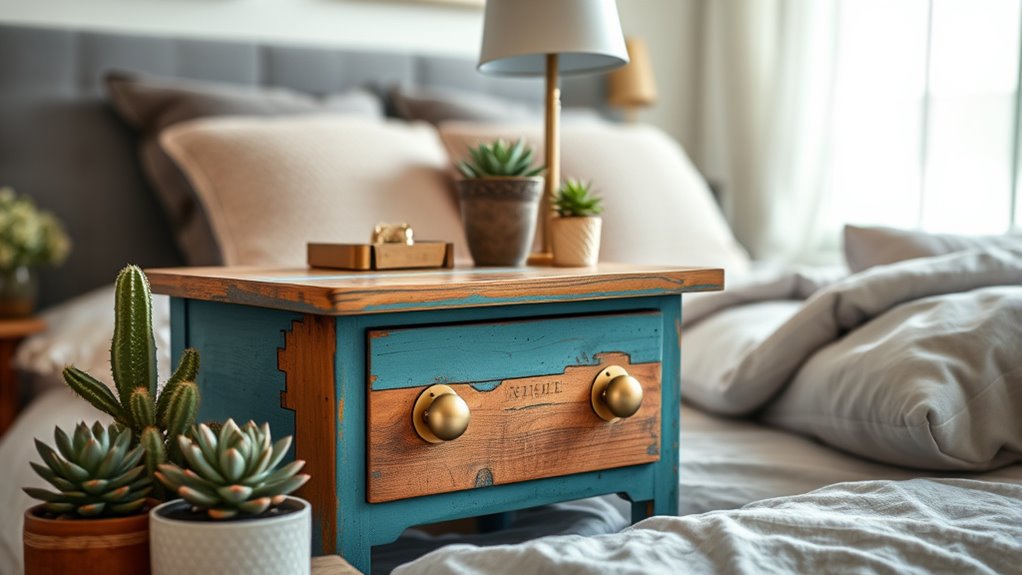
Transforming old nightstands into eye-catching side tables offers a practical and creative way to refresh your space. Start by removing hardware like handles or knobs, which can be reused or replaced to update the look. Clean and lightly sand the surface to assure paint or finishes adhere smoothly, especially when using chalk paint for a matte finish. Incorporating upcycling techniques that promote sustainability and reduce waste can further enhance your project. You can also incorporate reclaimed materials, such as shutters or cinder blocks, to add texture and height. Painting the nightstand in vibrant colors or combining industrial elements with greenery creates a modern, minimalist vibe. Additionally, choosing self watering planters to place on your new tables can help showcase your plants while making maintenance easier. It is also helpful to consider reclaimed materials that can add character and uniqueness to your design. For added functionality, consider adding new hardware, open shelves, or even splitting a single piece into two wall-mounted tables. This approach maximizes your furniture’s potential while supporting sustainable practices.
Creating Custom Storage Solutions From Old Furniture
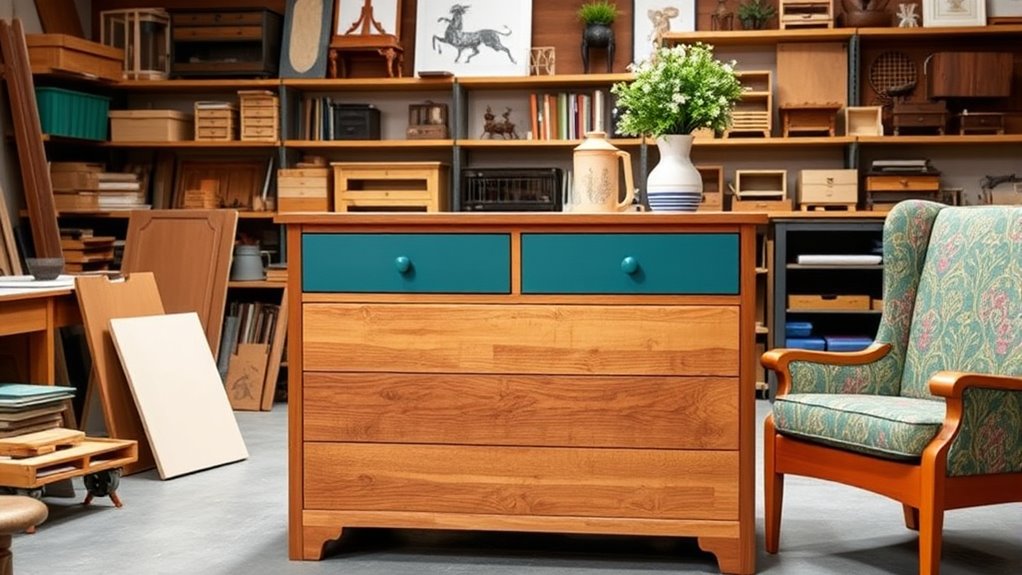
Old furniture pieces can be reinvented into practical storage solutions that suit your space and style. You can repurpose dressers by removing some drawers to create open shelving for books, baskets, or decorative items. Inside the drawers, adding dividers or compartments helps organize smaller items like accessories or office supplies.
Refinishing or painting dressers boosts their look while providing compact storage in bedrooms or living areas. For better ventilation, replace drawer fronts with wire mesh or fabric panels—perfect for shoes or linens.
You can also convert dressers into stylish sideboards or buffet tables by adding shelves or racks for kitchen or dining storage. These customized solutions maximize your space and give old furniture a fresh, functional purpose.
Combining Painting and Distressing for a Vintage Look
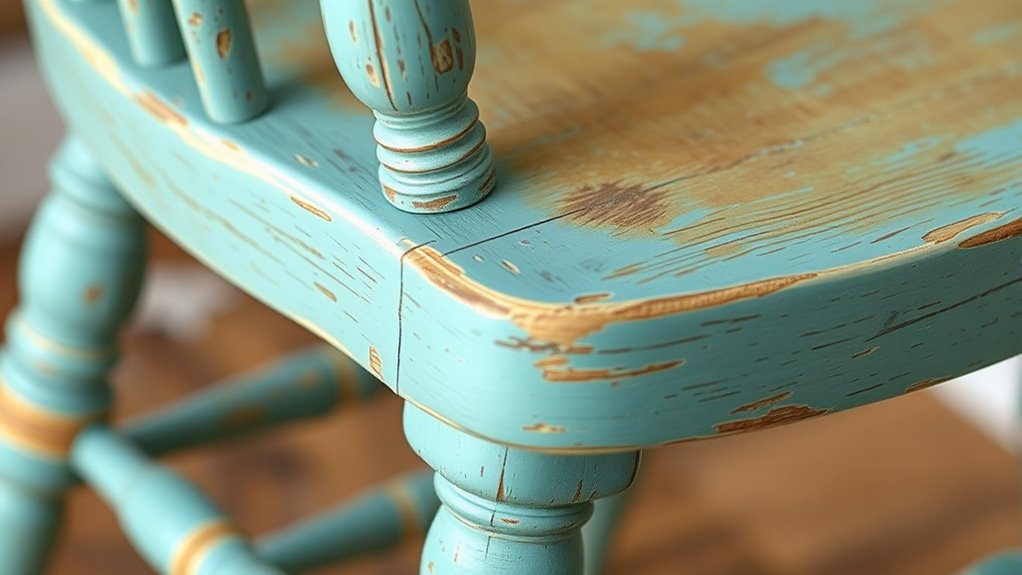
Achieving an authentic vintage look through painting and distressing requires a thoughtful approach to both preparation and technique. First, thoroughly clean the furniture to remove dirt, grease, and wax, then lightly sand with fine-grit paper to ensure good paint adhesion.
Repair cracks with wood filler and mask areas you don’t want painted. Use a primer if covering dark wood for better color vibrancy and durability.
For the base, apply chalk or milk paint in thin, even coats, allowing each layer to dry completely. Use dry brushing and layered contrasting colors to add depth.
Once the paint is dry, distress by gently sanding edges, corners, and raised details with fine to medium grit sandpaper or steel wool.
Finish with wax or matte varnish to preserve the vintage effect.
Frequently Asked Questions
What Are the Best Tools for Upcycling Furniture Effectively?
You want to upcycle furniture effectively, so start with essential tools. Use a jigsaw for precise cuts, a power drill for disassembly and assembly, and clamps to hold pieces securely.
Sandpaper or an electric sander smooth surfaces, while brushes or a paint sprayer apply finishes evenly.
Don’t forget safety gear, like gloves and goggles, to safeguard yourself. Combining these tools ensures your project is efficient, safe, and results in a stunning finished piece.
How Can I Choose the Right Paint Finish for Durability?
When choosing a paint finish for durability, consider how you’ll use the furniture and its material.
Satin finishes offer a good balance of sheen and durability, perfect for most projects.
If you want a high-shine look, go for gloss.
For vintage or distressed styles, chalk paint works well.
Always prep the surface properly, use quality paint, and apply techniques carefully to guarantee the finish lasts longer and withstands wear.
What Eco-Friendly Materials Are Recommended for Sustainable Upcycling?
Imagine your furniture as a blank canvas, ready to showcase nature’s best. You should choose reclaimed wood for durability and reducing waste, recycled metals or plastics for eco-conscious strength, and bamboo for a fast-growing sustainable option. Organic cotton, hemp, and jute work well for upholstery and accents. These materials not only save resources but also add unique character, making your project both beautiful and kind to the planet.
How Do I Safely Remove Old Paint or Varnish Before Beginning?
To safely remove old paint or varnish, start by working in a well-ventilated area or outdoors.
Wear gloves and a mask to protect your skin and respiratory system.
Apply a low-odor chemical stripper evenly, cover with plastic wrap, and let it sit for the recommended time.
Use plastic scrapers or brushes to gently remove the softened finish.
Then wipe down the surface with a damp rag to clean up residue.
What Are Common Mistakes to Avoid During Furniture Upcycling?
Did you know that poor surface preparation causes upcycled furniture to fail 80% of the time?
When avoiding common mistakes, you should thoroughly clean, strip, and sand your pieces first.
Don’t skip removing hardware or sanding old paint, as it leads to uneven finishes.
Use appropriate products, follow application instructions, and plan ahead.
This guarantees your project looks professional, lasts longer, and saves you from costly redo’s.
Conclusion
By upcycling your old furniture, you’re not just creating new pieces—you’re breathing life into forgotten treasures and transforming your space into a gallery of your creativity. Every scratch and paint stroke tells a story, making your home a masterpiece of imagination. So, don’t just settle for ordinary—turn your clutter into extraordinary art and prove that with a little effort, you can redefine what’s possible in your home.





